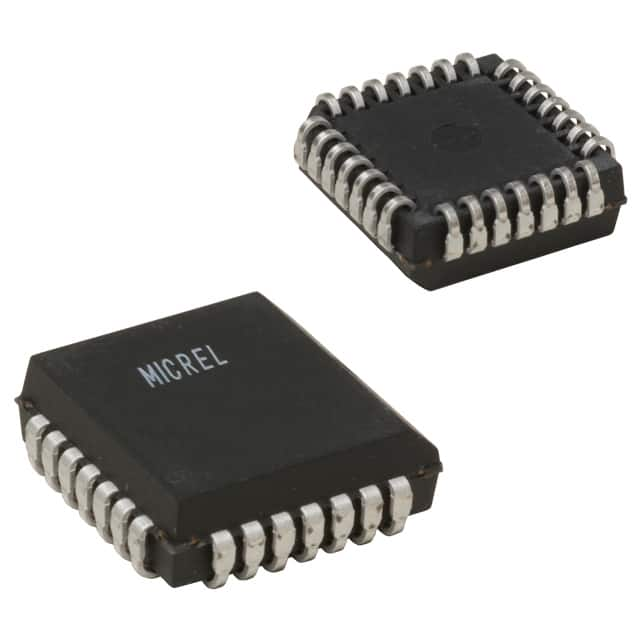Consulte las especificaciones para obtener detalles del producto.

SY100E336JC
Basic Information Overview
- Category: Integrated Circuit (IC)
- Use: Logic Gate
- Characteristics: High-speed, ECL (Emitter-Coupled Logic) technology
- Package: Ceramic Dual-In-Line Package (CDIP)
- Essence: 4-bit Magnitude Comparator
- Packaging/Quantity: Tray, 25 pieces per tray
Specifications
- Supply Voltage: -4.2V to -5.7V
- Operating Temperature Range: -40°C to +85°C
- Input Voltage Range: -3.0V to -5.7V
- Output Voltage Range: -3.0V to -5.7V
- Propagation Delay Time: 1.8 ns (typical)
- Power Dissipation: 500 mW (max)
Detailed Pin Configuration
SY100E336JC has a total of 20 pins. The pin configuration is as follows:
| Pin Number | Pin Name | Description | |------------|----------|-------------| | 1 | A0 | Input A0 | | 2 | A1 | Input A1 | | 3 | A2 | Input A2 | | 4 | A3 | Input A3 | | 5 | B0 | Input B0 | | 6 | B1 | Input B1 | | 7 | B2 | Input B2 | | 8 | B3 | Input B3 | | 9 | GND | Ground | | 10 | Q0 | Output Q0 | | 11 | Q1 | Output Q1 | | 12 | Q2 | Output Q2 | | 13 | Q3 | Output Q3 | | 14 | VEE | Negative Supply Voltage | | 15 | VCC | Positive Supply Voltage | | 16 | A>B | Output A>B | | 17 | A=B | Output A=B | | 18 | A<B | Output A<B | | 19 | GND | Ground | | 20 | NC | No Connection |
Functional Features
- Performs 4-bit magnitude comparison between two inputs (A and B)
- Outputs three signals indicating the relationship between A and B: A>B, A=B, A<B
- Utilizes ECL technology for high-speed operation
- Provides accurate and reliable comparison results
Advantages and Disadvantages
Advantages: - High-speed operation due to ECL technology - Accurate and reliable comparison results - Suitable for applications requiring fast magnitude comparison
Disadvantages: - Requires negative supply voltage - Limited operating temperature range (-40°C to +85°C)
Working Principles
SY100E336JC compares the magnitude of two 4-bit inputs (A and B) using ECL technology. It determines whether A is greater than, equal to, or less than B, and provides corresponding output signals (A>B, A=B, A<B). The circuitry inside the IC performs logical operations based on the input values and generates the appropriate output signals.
Detailed Application Field Plans
SY100E336JC can be used in various applications that require fast and accurate magnitude comparison. Some potential application fields include: 1. Digital signal processing systems 2. Arithmetic units in microprocessors 3. Data sorting and searching algorithms 4. Communication systems for error detection and correction 5. Industrial control systems for precise measurements
Detailed and Complete Alternative Models
Some alternative models that can be considered as alternatives to SY100E336JC are: 1. SN74F521DW - 8-bit Magnitude Comparator IC 2. CD54HC688F3A - 8-bit Identity Comparator IC 3. MC14585BCP - 4-bit Magnitude Comparator IC
These alternative models offer similar functionality and can be used as substitutes depending on specific requirements and compatibility with the existing system.
Word count: 446 words
Enumere 10 preguntas y respuestas comunes relacionadas con la aplicación de SY100E336JC en soluciones técnicas
Sure! Here are 10 common questions and answers related to the application of SY100E336JC in technical solutions:
Q: What is SY100E336JC? A: SY100E336JC is a specific type of integrated circuit (IC) that belongs to the SY100E336 series. It is commonly used in high-speed digital applications.
Q: What are the key features of SY100E336JC? A: SY100E336JC features differential inputs, high-speed operation, low power consumption, and compatibility with other ECL logic families.
Q: What are the typical applications of SY100E336JC? A: SY100E336JC is often used in clock distribution systems, data communication networks, high-speed data processing, and other applications requiring precise timing.
Q: What is the operating voltage range for SY100E336JC? A: The operating voltage range for SY100E336JC is typically between -4.2V and -5.7V.
Q: How fast can SY100E336JC operate? A: SY100E336JC has a maximum propagation delay of around 1.5 nanoseconds, allowing it to handle high-speed signals.
Q: Can SY100E336JC be used in both single-ended and differential applications? A: No, SY100E336JC is specifically designed for differential applications and may not perform optimally in single-ended configurations.
Q: Is SY100E336JC compatible with other logic families? A: Yes, SY100E336JC is compatible with other ECL (Emitter-Coupled Logic) logic families, such as the SY10/100E series.
Q: Does SY100E336JC require external components for operation? A: Yes, SY100E336JC typically requires external termination resistors and decoupling capacitors for proper operation.
Q: Can SY100E336JC tolerate high temperatures? A: Yes, SY100E336JC is designed to operate within a wide temperature range, typically from -40°C to 85°C.
Q: Where can I find more information about SY100E336JC? A: You can refer to the datasheet provided by the manufacturer or visit their official website for detailed information on SY100E336JC's specifications and application notes.
Please note that the answers provided here are general and may vary depending on specific design considerations and requirements.

